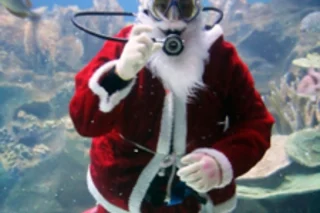It’s the kind of news that caffeine-addled journalists latch onto and quickly blow out of proportion: The North Pole may be ice-free by the end of this summer. Will we really see a Waterworld-like apocalypse by September? Not quite. As New York Times blogger, Andy Revkin, points out, no tenured ice researcher could make this kind of prediction with high confidence. There are far too many variables to pinpoint exactly how much melt a summer will bring. Furthermore, an “ice-free” North Pole, as so many headlines have shouted, is a bit misconstrued. This summer there very well may be “open water,” a giant lake’s worth of melt that opens to Pacific or Atlantic water, says Andy Mahoney, a researcher at the National Snow and Ice Data Center. “However, this is a very different thing than an ice-free Arctic,” he says. “The Arctic ice cover is constantly in motion. At any ...
2008: The Summer Santa Drowned?
The North Pole may be ice-free soon, marking a historic milestone in global warming and impacting Arctic shipping routes.
More on Discover
Stay Curious
SubscribeTo The Magazine
Save up to 40% off the cover price when you subscribe to Discover magazine.
Subscribe













